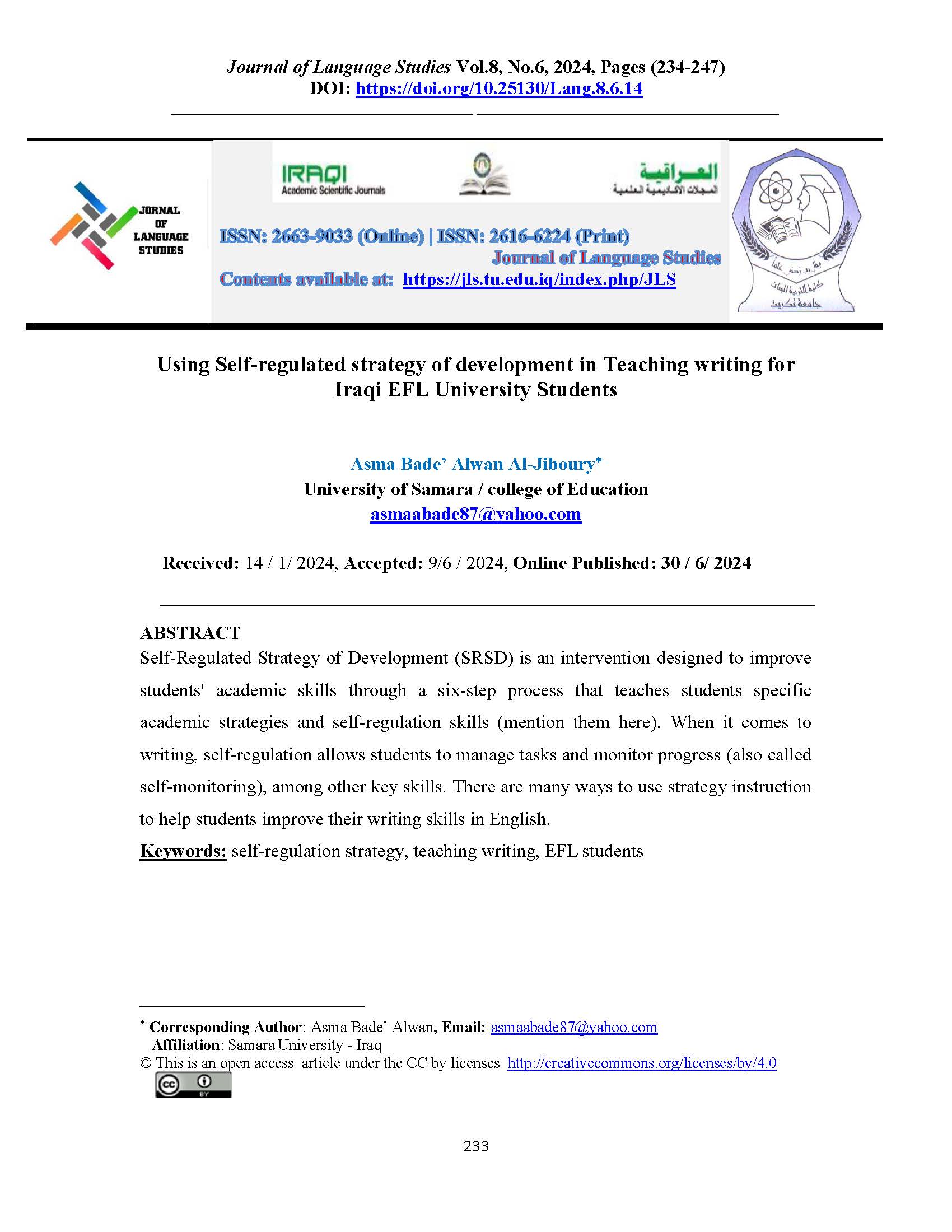Using Self-regulated strategy of development in Teaching writing for Iraqi EFL University Students
DOI:
https://doi.org/10.25130/Lang.8.6.14Keywords:
self-regulation strategy, teaching writing, EFL studentsAbstract
Self-Regulated Strategy of Development (SRSD) is an intervention designed to improve students' academic skills through a six-step process that teaches students specific academic strategies and self-regulation skills (mention them here). When it comes to writing, self-regulation allows students to manage tasks and monitor progress (also called self-monitoring), among other key skills. There are many ways to use strategy instruction to help students improve their writing skills in English.
References
- Abdullah , Elaf Subhi and Mousa, Manal Omar (2023) The Correlation between Discourse and Syntactic Awareness of EFL University Teachers and Students’ Writing Performance. Journal of Language Studies. Vol.8, No.1, 2024, Pages (305-336) DOI: https://doi.org/10.25130/lang.8.1.14
- Berry, A. and Mason, L. (2010). The Effect of Self- Regulated Learning Strategy Development on the Writing of Expository Essay for Adults with Written Expression Difficulties:Preparing for the GED.Remedial and Special Education.doi:101177/0741932510375469
- Cumming, A. (2001). Learning to write in a second language: Two decades of research. International Journal of English Studies, 1(2), 1–23
- Erlbaum. Graham, S., Harris, K.R., & McKeown, D. (2013). The writing of students with learning disabilities: Meta-analysis of self-regulated strategy development writing intervention studies and future directions: Redux. In H.S. Swanson, K. Harris, & S. Graham (Eds.), Handbook of learning disabilities (2nd ed.), (pp. 565–590). New York: Guilford Press.
- Fathman, A.K. & Walley, E. (1990). Teacher response to student writing: focus on form versus content. In B. Kroll (Ed.), Second language writing (pp. 178–190). Cambridge: Cambridge University Press.
- Ferris, D.R. (2012). Writing instruction. In J.C. Richards, & A. Burns (Eds.), Cambridge guide to pedagogy and practice in second language teaching (pp. 226–235). Cambridge: Cambridge University Press.
- Graham, S., & Perin, D. (2007). Writing next: Effective strategies to improve writing of adolescents in middle and high school. Washington, DC: Alliance for Excellence in Education.
- Graham, S., & Harris, K. R. (2005). Improving the writing performance of young struggling writers: Theoretical and programmatic research from the center on accelerating student learning. The Journal of Special Education, 39, 19-33.
- Harris, K. R., & Graham, S. (2009). Making the writing process work: Strategies for composition and selfregulation. Cambridge, MA: Brookline. Lerner, J. (2000). Learning Disabilities. Boston: Houghton Mifflin.
- Graham, S., & Harris, K. (1996). Self-regulation and strategy instruction for students who find writing and learning challenging. In C.M. Levy, & S. Ransdell (Eds.), The science of writing: theories, methods, individual differences, and applications (pp. 347–360). Mahwah, NJ:
- Graham, S. & Mason, L. H., (2008). Writing instruction for adolescents with learning disabilities: Programs of intervention research. Learning Dis-abilities Research and Practice, 23, 103–112. (21) (PDF) Self-Regulated Strategy Development for Students With Writing Difficulties. Available from: https://www.researchgate.net/publication/233057622_Self-Regulated_Strategy_Development_for_Students_With_Writing_Difficulties
- Hyland, K. (2015). Teaching and researching writing. (3rd ed.). New York: Routledge. International Literacy Association/National Council of Teachers of English. (2016).Write-alouds. Retrieved from http://www.readwritethink.org/professional-development/strategy-guides/writealouds-30687.html Kasper
- Harris, K. R., Graham, S., Mason, L. H., & Fried lander, B. (2008). Powerful writing strategies for all students. Baltimore, MD: Brooks.
- Harris, K. R., Graham, S., MacArthur, C., Reid, R.,& Mason, L. H. (2013). Self-regulated learningprocesses and children’s writing. In B. Zimmer-man & D. H. Schunk (Eds.), Handbook of self-regulation of learning and performance. Danvers,MA: Routledge. (21) (PDF) Self-Regulated Strategy Development for Students With Writing Difficulties. Available from: https://www.researchgate.net/publication/233057622_Self-Regulated_Strategy_Development_for_Students_With_Writing_Difficulties
- Harris, K. R., Graham, S., Reid, R., McElroy, K., & Hamby, R. (2008). Self-monitoring of attention versus self-monitoring of performance: Replication and cross-task comparison studies. Learning Disabilities Quarterly, 17, 121-139.
- Hattie J, Biggs J and Purdie N (1996) Effects of learning skills interventions on student learning: a meta-analysis. Review of Educational Research 66: 99±136.
(21) (PDF) Self‐Regulated Learning. Available from: https://www.researchgate.net/publication/229971208_Self-Regulated_Learning [accessed Jan 19 2024].
- Hesket, T.(2010).Using the Traits of Good Writing Grades 6-8.2nd Edition Westminster, CA: Teacher Created Resources, Inc. Hogan ,G.(2012).Building Better Essays. Boston: Wadsworth, Cengage Learning
- Keh, C L. (2000). Feedback in the writing process: A model and methods for implementation. EFL Journal, 44(4), 294–304
- MacArthur, C., Graham, S., & Harris, K. R. (2004). Insights from instructional research on revision with struggling writers. In L. Allal, L. Chanquoy, & P. Largy (Eds.), Revision: Cognitive and instructional processes (pp. 125-137). Boston: Kluwer Academic Publishers.
- Mason, L., Harris, K. R., & Graham, S. (2002). Every child has a story to tell: Self-Regulated Strategy Development for story writing. Education and Treatment of Children, 25, 496- 506.

